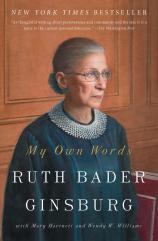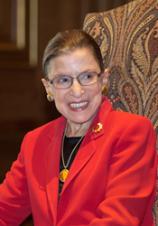My Own Words
Review
My Own Words
Ruth Bader Ginsburg addresses her good readers with an explanation of how MY OWN WORDS came into being. She was visited in chambers in 2003 by Mary Hartnett and Wendy W. Williams, who volunteered to be her official biographers. Williams, equally invested in the law since the ’70s and a founder of the San Francisco-based Equal Rights Advocates, was on the faculty of Georgetown University Law Center. Hartnett was an adjunct professor there, and she was smart and sympathique --- an excellent partner in this venture. With no hesitation, Ginsburg accepted their offer. However, they changed course and decided to write her biography closer to the end of her term on the Supreme Court. They instead collected and edited landmark pieces of writing and talking engagements that are helpful in showing characteristics of Ginsburg, as well as establishing the national changes that have occurred since her birth in 1933.
The first section of the book is somewhat chronological, beginning with Ginsburg’s 1946 high school editorial charging the children of public schools to promote peace and to support the newly created United Nations. The second and third parts are devoted to acknowledging those who have paved the way for her and the cases and background on gender equality.
"This carefully explained collection of Ginsburg’s work shows by fascinating examples what this brilliant, persuasive woman has contributed to today’s America."
The fourth very brief section contains her nomination to and ratification for her appointment to the Supreme Court. Her acceptance speech in the Rose Garden with President Clinton standing beside her is both moving and strong; it shows again her intelligence, humor and respect for that moment and the possibilities she envisions.
The final segment gives samples of Ginsburg’s articles on the nature of the Court, the job of the Justices, and the standards they observe. Her style is “modest and measured” yet distinctive; she may capture her views in a pithy quotation from someone else. (A brief aside details Ginsburg’s ability to go without sleep and pull all-nighters, a habit begun in high school when she would slip away and study after others were in bed.)
An early chapter centers on Louis Dembitz Brandeis, the first Jew to serve on the Supreme Court. Brandeis’ leitmotif as lawyer and later judge was his emphasis on the obligations of women regarding citizenship: “We cannot relieve her from the duty of taking part in public affairs.” This strong directive from one of Ginsburg’s role models continues to shape her life and work ethic.
Ginsburg’s sweet devotion to her husband, Marty, and her realistic reservations about her cooking abilities are just a few of the pieces of her personal life that come to light.
One of the pieces in the concluding chapter on Highlights of the 2015-16 Supreme Court Term revisits the Whole Woman’s Health case from Texas. We are given a description of how the brilliant, incisive questioning of Judge Ginsburg, Justice Kagan and Justice Sotomayor dominated the bench. A blog for Slate crowed: “It felt as if, for the first time in history, the gender playing field at the high court was finally leveled.” Judge Ginsburg’s words were quoted again and again when she reminded the defense attorney that “a woman has a fundamental right to make this [abortion] choice for herself.” Her cut-to-the chase approach is seen after she joined Justice Bryer’s 40-page opinion with a concurring opinion reminding us what life was like before abortion became legal. She fully subscribed to everything Justice Bryer wrote, she said, but wanted something concise. “I wrote to say, ‘Don’t try this anymore.’” Her keen awareness of just how wrong Texas lawmakers were is amplified by her imperative: Stop trying to control women’s lives.
Entertaining may not be the first word that comes to mind when choosing MY OWN WORDS from a bookshelf. But, somehow, it describes exactly the spirit of this memoir. This carefully explained collection of Ginsburg’s work shows by fascinating examples what this brilliant, persuasive woman has contributed to today’s America.
Reviewed by Jane Krebs on October 12, 2016
My Own Words
- Publication Date: August 7, 2018
- Genres: Law, Nonfiction, Political Science, Politics
- Paperback: 400 pages
- Publisher: Simon & Schuster
- ISBN-10: 1501145258
- ISBN-13: 9781501145254





